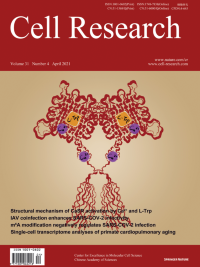
Advanced Search
Submit Manuscript
Advanced Search
Submit Manuscript
Volume 31, No 4, Apr 2021
ISSN: 1001-0602
EISSN: 1748-7838 2018
impact factor 17.848*
(Clarivate Analytics, 2019)
Volume 31 Issue 4, April 2021: 383-394 |
Structural mechanism of cooperative activation of the human calcium-sensing receptor by Ca2+ ions and L-tryptophan
Shenglong Ling1 , Pan Shi1 , Sanling Liu1 , Xianyu Meng1 , Yingxin Zhou1 , Wenjing Sun1 , Shenghai Chang2 , Xing Zhang2 , Longhua Zhang1 , Chaowei Shi1 , Demeng Sun1,* , Lei Liu3,* , Changlin Tian1,4,5,*
1Hefei National Laboratory of Physical Sciences at Microscale, Anhui Laboratory of Advanced Photonic Science and Technology, and School of Life Sciences, University of Science and Technology of China, Hefei, Anhui 230026, ChinaThe human calcium-sensing receptor (CaSR) is a class C G protein-coupled receptor (GPCR) responsible for maintaining Ca2+ homeostasis in the blood. The general consensus is that extracellular Ca2+ is the principal agonist of CaSR. Aliphatic and aromatic L-amino acids, such as L-Phe and L-Trp, increase the sensitivity of CaSR towards Ca2+ and are considered allosteric activators. Crystal structures of the extracellular domain (ECD) of CaSR dimer have demonstrated Ca2+ and L-Trp binding sites and conformational changes of the ECD upon Ca2+/L-Trp binding. However, it remains to be understood at the structural level how Ca2+/L-Trp binding to the ECD leads to conformational changes in transmembrane domains (TMDs) and consequent CaSR activation. Here, we determined the structures of full-length human CaSR in the inactive state, Ca2+- or L-Trp-bound states, and Ca2+/L-Trp-bound active state using single-particle cryo-electron microscopy. Structural studies demonstrate that L-Trp binding induces the closure of the Venus flytrap (VFT) domain of CaSR, bringing the receptor into an intermediate active state. Ca2+ binding relays the conformational changes from the VFT domains to the TMDs, consequently inducing close contact between the two TMDs of dimeric CaSR, activating the receptor. Importantly, our structural and functional studies reveal that Ca2+ ions and L-Trp activate CaSR cooperatively. Amino acids are not able to activate CaSR alone, but can promote the receptor activation in the presence of Ca2+. Our data provide complementary insights into the activation of class C GPCRs and may aid in the development of novel drugs targeting CaSR.
https://doi.org/10.1038/s41422-021-00474-0